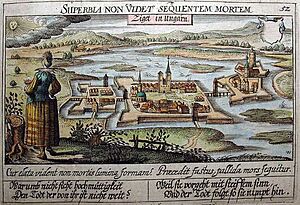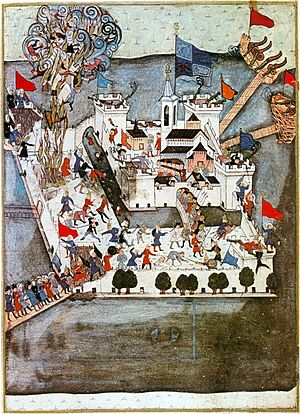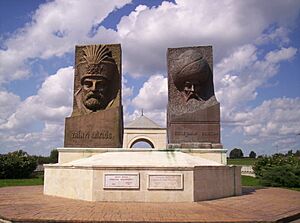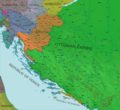Siege of Szigetvár facts for kids
Quick facts for kids Siege of SzigetvárBattle of Szigeth |
|||||||||
|---|---|---|---|---|---|---|---|---|---|
| Part of the Ottoman–Habsburg wars Ottoman wars in Europe Ottoman-Habsburg War (1565-1568) |
|||||||||
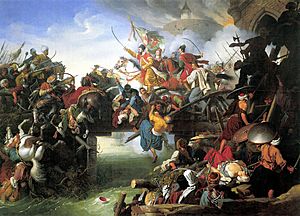 Nikola IV Zrinski's charge from the fortress of Szigetvár (painting by Johann Peter Krafft, 1825) |
|||||||||
|
|||||||||
| Belligerents | |||||||||
|
|
||||||||
| Commanders and leaders | |||||||||
| Nikola IV Zrinski † | Suleiman I # Sokollu Mehmed Pasha |
||||||||
| Strength | |||||||||
|
2,300–3,000 Croats and Hungarians
|
100,000
|
||||||||
| Casualties and losses | |||||||||
|
Whole army killed;
|
Heavy;
|
||||||||
The Siege of Szigetvár was a big battle that happened in 1566. It was fought at the fortress of Szigetvár in what is now Hungary. This fortress was important because it blocked the path of the Ottoman Empire's army towards Vienna.
The battle was between the defending forces of the Habsburg monarchy (a powerful European family) and the invading Ottoman army. The Habsburg forces were led by Nikola IV Zrinski, a Croatian hero. The Ottoman army was led by their great ruler, Suleiman the Magnificent.
The siege lasted for over a month, from August 5 to September 8, 1566. Both sides suffered huge losses. The Ottomans won the battle, but it was a very costly victory for them. Both commanders, Zrinski and Suleiman, died during the siege. This battle stopped the Ottomans from attacking Vienna that year.
Some people, like the French leader Cardinal Richelieu, even said this battle "saved Western civilization." It's still a famous story in Croatia and Hungary. It inspired poems and an opera.
Contents
A Look Back in Time
Before the Siege of Szigetvár, there was a big battle in 1526 called the Battle of Mohács. In this battle, the Ottoman army defeated the Kingdom of Hungary. The Hungarian king died, and Hungary became a disputed land.
After this, Ferdinand I from the Habsburg family was chosen as king by nobles in Hungary and Croatia. This led to many fights between the Habsburgs and the Ottoman Empire. Both sides fought hard and lost many soldiers.
The Little War
The years from 1529 to 1552 are known as the "Little War." During this time, the Ottomans tried to capture Vienna in 1529 but failed. Ferdinand tried to fight back and took some forts.
In 1532, Suleiman led a huge army to try and capture Vienna again. But a small group of 800 Croatian soldiers, led by Nikola Jurišić, bravely defended a small town called Güns. They held out for over 25 days against 120,000 Ottomans! This amazing defense made the Ottomans retreat.
Later, there were more battles. The Ottomans captured the city of Buda in 1541. They also took other important cities like Esztergom and Székesfehérvár. This gave them more control over Hungary.
In 1552, the Ottomans tried to capture Eger, but they failed. This victory for the Habsburgs showed that Hungary was still a contested land. After this, the fighting in Hungary calmed down until 1566.
The Campaign of 1566
In January 1566, Sultan Suleiman I, the ruler of the Ottoman Empire, decided to go to war one last time. He was 72 years old and not well, but he still led his army. On May 1, 1566, he left Istanbul with one of his biggest armies ever.
On the other side was Count Nikola IV Zrinski. He was a very experienced soldier and a leader in Croatia. He had fought bravely in many battles, including the first Siege of Vienna.
Suleiman's army reached Belgrade in June. He heard that Zrinski had attacked an Ottoman camp. So, Suleiman changed his plans. Instead of attacking another city, he decided to attack Zrinski's fortress at Szigetvár. He wanted to remove Zrinski as a threat.
The Big Fight Begins
The first Ottoman soldiers arrived at Szigetvár on August 2, 1566. The defenders of the fortress fought back well, causing losses to the Ottomans. Sultan Suleiman arrived with his main army on August 5. He set up his big tent on a hill to watch the battle. He got updates from his main commander, Sokollu Mehmed Pasha.
Count Zrinski and his small army of about 2,300 Croatian and Hungarian soldiers were now surrounded. The Ottoman army had at least 150,000 soldiers and powerful cannons. The defenders were greatly outnumbered.
Szigetvár fortress was split into three parts by water: the old town, the new town, and the castle. They were connected by bridges. The inner castle was hard to reach because the other two parts had to be captured first.
When Suleiman arrived, he saw red flags on the fortress walls, like a party. A single cannon fired to greet him. The siege officially began on August 6. The Ottomans launched a big attack, but the defenders pushed them back. Even though they were few, no extra soldiers were sent to help them from Vienna.
After more than a month of hard fighting, the few remaining defenders went into the old town for their last stand. The Sultan tried to get Zrinski to give up, even offering him control of Croatia. But Zrinski refused and kept fighting. Meanwhile, a large Habsburg army was nearby but did not help Szigetvár.
The Final Moments
On September 6, Sultan Suleiman died in his tent. His death was kept a secret for 48 days. The Ottomans feared their soldiers would lose hope if they knew their leader was gone. Only a few trusted people knew. A message was sent to Suleiman's son, Selim II, to tell him he was the new Sultan.
The Last Stand
The final battle started on September 7, the day after Suleiman died. By this time, the fortress walls were mostly destroyed by explosions and fires. In the morning, the Ottomans launched a huge attack. They fired guns, used "Greek fire" (a type of ancient flamethrower), and shot many cannonballs. The castle, the last part of Szigetvár, caught fire.
The Ottoman army rushed into the city, making lots of noise. Zrinski prepared for a final charge. He told his soldiers: "Let us go out from this burning place into the open and stand up to our enemies. Who dies – he will be with God. Who dies not – his name will be honored. I will go first, and what I do, you do. And God is my witness – I will never leave you, my brothers and knights!"
As the Ottomans pushed across a narrow bridge, Zrinski's men suddenly opened the gate. They fired a huge cannon loaded with broken iron, killing 600 attackers. Then, Zrinski led his remaining 600 soldiers out of the castle. He was shot twice in the chest and then killed by an arrow to the head. Most of his men were also killed. Only a few defenders managed to escape.
The Big Explosion
Before his final charge, Zrinski had ordered a fuse to be lit to the castle's powder room. After the Ottomans took the castle, thousands of them rushed in. They fell into a trap! The powder room exploded, killing thousands of Ottoman soldiers.
The Ottoman commander, Sokollu Mehmed Pasha, was warned by a prisoner just in time. The prisoner told him that 3,000 pounds of gunpowder were about to explode. The Pasha and his officers barely escaped, but many other Ottoman soldiers died in the blast.
What Happened Next
Almost all of Zrinski's soldiers died in the battle. The Ottomans also suffered huge losses. It's believed that between 20,000 and 35,000 Ottoman soldiers died from fighting and sickness.
After the battle, the Ottoman commander kept Suleiman's death a secret. He sent messages pretending they were from the Sultan, saying he was too sick to continue the campaign. Suleiman's body was secretly taken back to Istanbul. This secret was kept for weeks.
Suleiman's death meant that the Ottoman army had to stop their advance. The commander had to return to Istanbul for the new Sultan, Selim II, to take power. Even if Suleiman had lived, his army was too tired to do much more before winter. The long fight at Szigetvár delayed the Ottoman push towards Vienna.
In 1568, a peace agreement was signed between the Habsburgs and the Ottomans. It brought 25 years of peace between the two empires. The Habsburgs agreed to pay a yearly tribute to the Ottomans.
Stories and Art
The Siege of Szigetvár became a very important story. A Croatian poet named Brne Karnarutić wrote an epic poem about it before 1573.
Zrinski's great-grandson, Nicholas VII of Zrin, also wrote a famous Hungarian epic poem called Szigeti Veszedelem in 1647. Even though the Zrinski family fought the Ottomans, the poem shows the Turks as human beings. It even includes a love story between a Tatar soldier and the Sultan's daughter.
Another Croatian poet, Pavao Ritter Vitezović, wrote a poem about the battle in 1684. His poem remembers the event without anger. It even has epitaphs (short writings for tombstones) for both Croatian and Turkish soldiers, showing respect for both sides.
The battle also inspired a German play called Zriny in 1812. In Croatia, Ivan Zajc's opera Nikola Šubić Zrinski, from 1876, is very famous. It tells the heroic story of the Croats fighting the Turks. Zrinski is shown as a hero who bravely fought until the end. The opera has a famous patriotic song called "U boj, u boj" (To battle, to battle).
Images for kids
-
The siege in Cosmographia by Sebastian Münster, 1600
-
Zrinyi's Charge from the Fortress of Szigetvár by Bertalan Székely, 1879-1885
-
Zrinyi's Charge from the Fortress of Szigetvár by Bertalan Székely, 1879-1885
-
A portrait by Oton Iveković, 19th century
-
Defense of Sziget against the Turks by Nicholas Zrinsky (1914), by Alphonse Mucha, The Slav Epic


